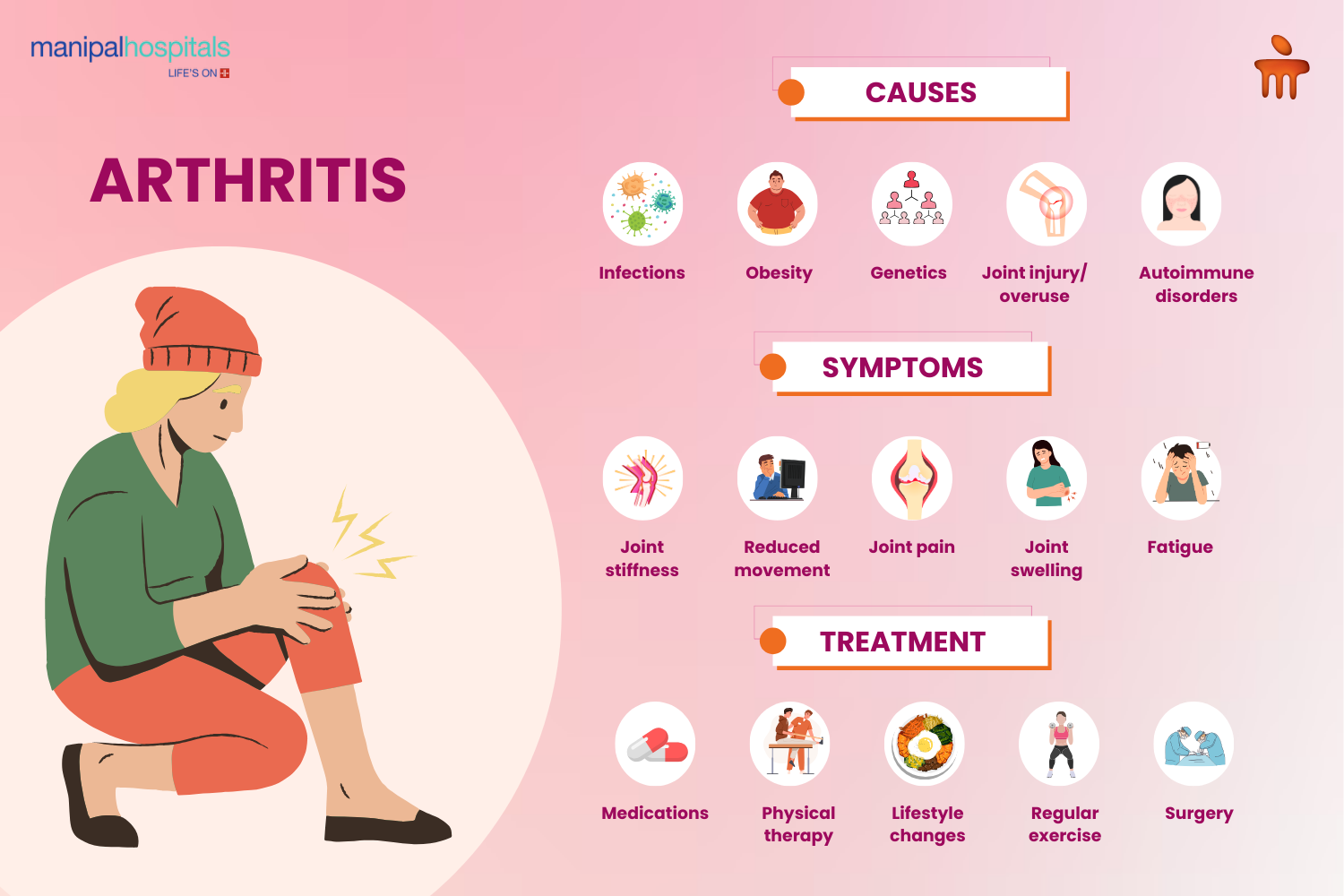
Arthritis is the swelling and tenderness that affects the joints, causing inflammation, pain, and stiffness. Most types of arthritis affect middle-aged and older people, but it can also occur in young adults. There are estimations where studies have stated that India will have 60 million osteoarthritis cases in 2025.
Those suffering from early onset arthritis encounter troublesome obstructions that influence their social lives, academic endeavours, and overall productivity. The variation arises as arthritis is determined in young individuals, making them feel estranged and misperceived by peers. It is more common in women and is one of the major causes of disability. This blog entails everything you need to know about arthritis in young adults.
Synopsis
Types of Arthritis in Young Adults
Among 100s types of arthritis, the most common one affecting the younger population is Juvenile Idiopathic Arthritis.
Common types of arthritis in young adults are:
-
Juvenile Idiopathic Arthritis: Juvenile arthritis affects children and teens, mostly under the age of 16. It is an autoimmune disorder that causes joint pain, inflammation, and stiffness.
-
Osteoarthritis: It is caused by the breakdown of cartilage, the tissue that cushions the joints. Osteoarthritis can affect any joint, but it is most common in the hands, knees, hips, and spine.
-
Ankylosing Spondylitis: It affects the spine and causes inflammation and stiffness.
-
Psoriatic Arthritis: It is associated with the skin condition psoriasis. Psoriatic arthritis can cause inflammation and pain in the joints, as well as skin lesions.
-
Rheumatoid Arthritis: A chronic autoimmune disorder that causes inflammation of joints and surrounding tissue. Rheumatoid arthritis can affect any joint, but it is most common in the hands, wrists, and feet.
-
Gout: A type of arthritis that is common in men from 30-60 years of age. Caused by a build-up of uric acid in the blood, gout can cause sudden, severe pain in the joints, especially the big toe.
Each types of arthritis have different symptoms and treatment options. Hence, getting an accurate diagnosis from a top orthopaedician in Bangalore is advised.
Causes of Arthritis in Young Adults

There are different factors contributing to the development of young adult arthritis:
-
Certain genes
-
Infection (Lyme disease or viral infections)
-
Autoimmune Disorders (Lupus)
-
Overweight or Obesity
-
Injury or Overuse (due to sports activities)
Common Arthritis Symptoms
Arthritis symptoms in young adults are based on the type and severity of the condition. However, the most commonly observed signs and symptoms of arthritis include:
-
Stiffness and joint pain, particularly in the morning or after inactivity
-
Swelling and tenderness in the joints
-
Reduced range of motion or flexibility
-
Fatigue or weakness
-
Skin rashes or other skin allergies (in psoriatic arthritis)
How Is the Diagnosis Made?
Diagnosing arthritis in young adults is achieved through several tests such as a physical examination of your joints for swelling, tenderness, and range of motion, blood tests, x-rays, CT scans, etc. Once a diagnosis is made, the doctors develop a personalised treatment plan for your condition.
Treatment for Arthritis in Young Adults
The medical treatment of arthritis alleviates symptoms and increases joint function. A patient may have numerous therapies or combinations of treatments before determining which works best.
-
Medications: Over-the-counter pain relievers, Nonsteroidal anti-inflammatory drugs (NSAIDs), and disease-modifying antirheumatic drugs (DMARDs) are proven arthritis pain relief measures that also reduce inflammation in the joints.
-
Physical therapy: It improves joint mobility and range of motion, strengthening muscles and fixing posture.
-
Lifestyle modifications: Maintaining a healthy weight, managing stress, avoiding activities that exacerbate joint pain, and managing arthritis symptoms in young adults.
Surgery for Arthritis
In cases where other arthritis treatments have failed to relieve pain and improve function, surgery can prove to be a very effective treatment for arthritis in young adults in repairing or replacing those damaged joints. The type of surgery depends on the type of arthritis, the severity of the symptoms, and the patient's overall health. Arthroscopy, fusion, and joint replacement are a few surgical interventions that can help patients with arthritis relieve their pain and restore mobility.
Talk to our orthopaedicians at Manipal Hospitals about the risks and benefits of the procedure before undergoing surgery.
Lifestyle Changes for Managing Arthritis
-
Weight Loss: Losing weight improves mobility and lessens the risk of joint damage, thus preventing arthritis progression.
-
Regular Physical Activity: For arthritis prevention and management, exercise regularly to keep joints flexible. Swimming and water Zumba are the best options as the buoyancy of the water decreases stress on weight-bearing joints.
-
Heat or Cold Therapy: Heating pads or ice packs are also beneficial in relieving arthritis pain.
-
Assisted Devices: Canes, walkers, shoe inserts, and other assistance safeguard joints and improve daily activities.
Arthritis affects people of all ages. However, many people associate arthritis with the elderly; adolescents and adults with the condition struggle to get support, wait longer for a proper diagnosis, and feel misunderstood. Proper medical supervision, psychological support, advocacy, and self-care can help manage early onset arthritis and enhance a young individual’s well-being.
FAQ's
You cannot reverse arthritis, but a combination of medical treatments and lifestyle management can slow down the growth and help you manage the condition.
Osteoarthritis normally affects people over 50 years of age, although it can also affect younger people. Younger individuals engaged in sports or other physical activities or with an injury such as a torn meniscus are more likely to acquire the disease earlier in life.
Some young arthritis people indicate that the condition worsens in specific weather conditions. Humidity and cold are typical causes of joint discomfort as people are less active during the rainy season and winter. Cold conditions can also tighten joints and worsen arthritis.





















 4 Min Read
4 Min Read










-_A_Life-Changing_Advance_in_Treating_Movement_and_Neurological_Disorders.png)







